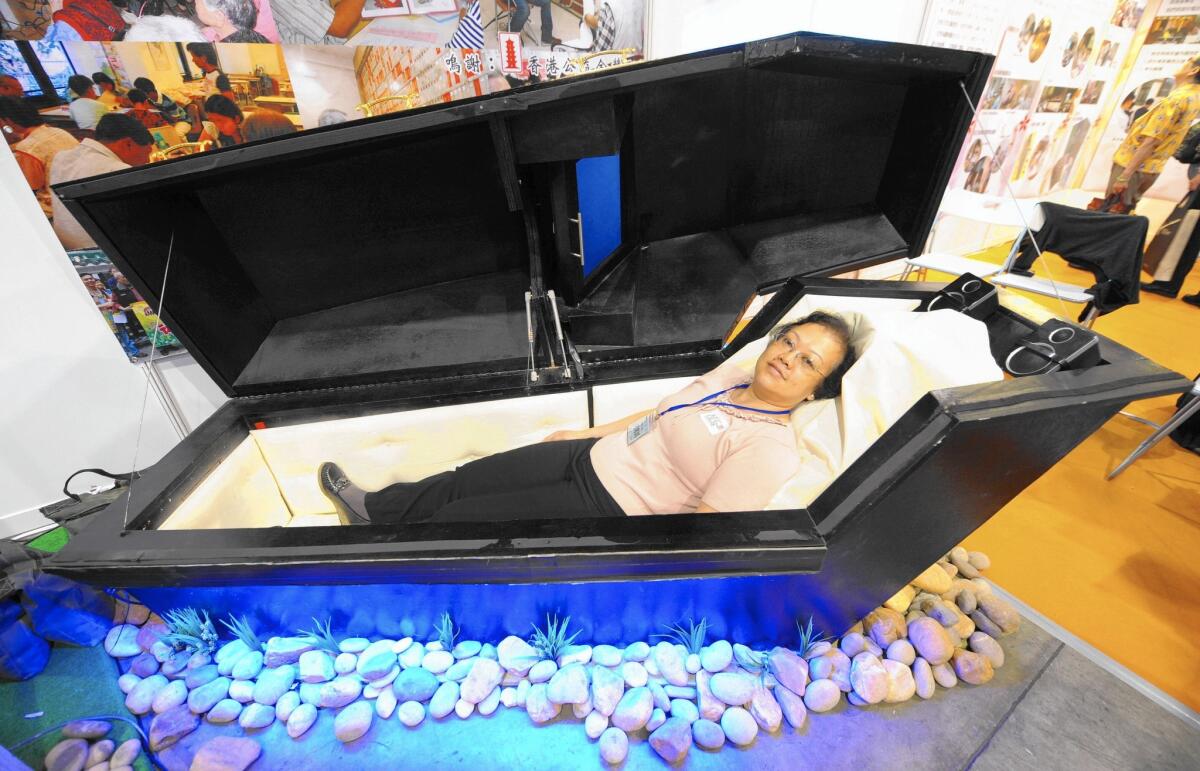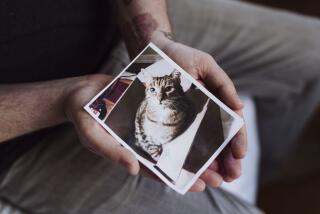Great Read: Growing demand for lavish funerals in Asia boosts annual expo

- Share via
MACAU — Nothing is a match for Lee Jonglan’s airbrush. Not the yellow tint of jaundice, not the gruesome wounds of gunshots, not the bones broken in high-speed car crashes.
“You see how the right side of her face looks normal,” Lee says as her petite model strains to keep her eyes closed. “But the left side, it looks a little bit swollen because we applied so much foundation.”
It’s not perfect, Lee notes. But then again, Lee isn’t hoping for perfection — she’s hoping to comfort the bereaved.
“Look at how beautiful she looks,” Lee says. The model, back from the dead, smiles, and the audience crowds around, business cards in hand.
Lee, South Korea’s top funerary beautician, couldn’t look more at home — and not just because of her TV star smile. She was in her element as more than 100 morticians, manufacturers, bureaucrats and entrepreneurs descended last month on the annual Asia Funeral and Cemetery Expo and Conference, which was held in Macau, a semiautonomous spit of land jutting off China’s southern coast.
For three days, participants from nearby Hong Kong to far-off Bolivia shook hands and swapped contact information. They met Mongolian morticians, Malaysian cemetery developers, Chinese coffin manufacturers and sharply dressed Dutch entrepreneurs who turn cremated ashes into gleaming synthetic diamonds, so that wealthy mourners can wear their loved ones’ remains. They sat beneath a crystal chandelier in a lush conference room, listening to lectures such as “DNA is Alive in the Death Industry’s DNA” and “Lessons from Ebola.”
“Asia’s funeral industry is quite different from the funeral industry in the West,” says Kenny Lo, chief executive of the conference’s Hong Kong-based organizer, Vertical Expo Services. “The industry here in Asia, especially the Chinese one, is very conservative. It’s very traditional. And to a certain extent — how can I say this — it’s not very open. Not so transparent.”
Standards are lax, he says. Government policies are often tortuous and inflexible. A vast range of traditions “makes things very complicated, even within one country.”
But for those in the know, Asian funerals are big business. Populations across the region, from Japan to Singapore, are growing older and more affluent. By 2050, 1 in 4 people in East Asia is expected to be 65 and older. Meanwhile, their children are becoming more tech-savvy and globally connected, and they’re seeking funerary services to match, prompting morticians to experiment with new ways of attracting clientele.
Nowhere has the industry changed faster than in China, the region’s largest economy, where families traditionally sent the departed off with offerings such as ersatz money, clothing and tools. For centuries, people saw extravagant funerals as a necessary means of pleasing the dead.
“The notion that the dead persist in some way after the physical extinction of life is very, very ancient in China,” says Michael Szonyi, a Chinese history professor at Harvard University. “It goes back way before Confucianism, way before Daoism, way, way before Buddhism.”
But Mao Tse-tung, who ruled the country from 1949 to 1976, branded traditional funeral rites as “feudal superstition” and replaced them with socialist-style funerals, called “memorial meetings.” Socialist funerals culminated in a short speech by the head of the deceased’s work unit praising the departed’s contributions to socialism. Few lasted more than 15 minutes.
Since then, however, China has transformed from a global backwater into an economic superpower, with more millionaires than any country but the United States — and ostentatious funerals have made a massive comeback despite official efforts to stamp them out.
In recent years, wealthy bereaved have made headlines with ceremonies befitting emperors. In 2011, an entrepreneur in the eastern city of Wenling spent $770,000 to see off his mother with massive LED screens, a 100-piece orchestra, a line of gold-painted cannons and a fleet of Lincoln limousines.
In April, government officials cracked down on two large-scale funerals in Hebei and Jiangsu provinces where villagers employed exotic dancers to attract large crowds.
It is perhaps no surprise that participation in the funeral expo has grown every year since Lo’s company began organizing the event.
Tucked away in a back corner of the exhibition hall, a Chinese company has set up a booth presenting samples of offerings for the dead — mostly large papier-mache sculptures of mansions and luxury cars, meant to be burned at cemetery furnaces as gifts for the departed.
Across the aisle, Han Dingyu unpacks a competing display for the nearly decade-old Taiwanese company SKEA, short for Spectacular Kind of Elysium Accessories. “The handiwork on these is top-notch,” Han says as he produces a smorgasbord of handcrafted paper miniatures, including an immaculate cut of roast beef, a tray of cupcakes and an assortment of colorful, quarter-sized macaroons.
The company produces paper models of anything that a person might want in the afterlife, he says: entertainment, sustenance, shelter.
“Young people often offer each other [miniature] iPhones,” he adds. “When people give offers to girls, it’s often makeup or clothes. Ancestors, old people, that’s who gets houses.”
He flips through the company’s glossy catalog, which advertises miniature homes with a range of luxurious features — rooftop patios, courtyard gardens, floor-to-ceiling windows. One postmodern “Ibiza-style Dream Villa” has a yacht moored in the backyard pool.
The spirit of adaptation extends well beyond China.
About five years ago, one of Singapore’s top funeral companies, the 103-year-old Ang Chin Moh group, launched Flying Home, a service that works with airlines and embassies to repatriate the recently deceased.
Not far from Lee’s funerary makeup booth, Flying Home representatives hand out luggage tags bearing the company’s insignia and pamphlets that resemble boarding passes (airline code “FH,” destination “home”).
Singapore is one of Asia’s top expatriate destinations, and Grace Hung, the company’s assistant marketing manager, says the company is doing brisk business.
“Singapore is so advanced when it comes to things like finance, accounting and law,” she says. “But not death.”
Her company is trying to change that. She says her co-workers speak a number of languages — Indonesian, Malay, English, Spanish, French — and have an average age of 40, about 10 years younger than the industry average.
“We do outbound as well,” she says. “Singapore is a medical hub — people come here seeking treatment, and sometimes they pass away.”
In the conference room downstairs, Chinese entrepreneur Wang Dan, a 34-year-old engineer who opened a Beijing funeral parlor in 2012, addresses an audience of a few dozen people, most of them well-dressed men.
“Social media is very important in our business,” he says. “When a person passes away, what can we do to extend our memories of the deceased for their family members or friends? We can make videos, take pictures, put them on the Internet. I think this is a very good idea.”
His company, the Other Shore, standardizes its prices and posts them online, he says, while most Chinese morticians charge whatever they believe their customers can pay. The company offers low-cost consultations, helping the bereaved connect with grief counseling services and reputable cemeteries; it has teamed with an American firm that launches cremated remains into space.
“I think the social structure is undergoing tremendous change,” he says. “Young people see the world very differently from us. And if we, as practitioners, don’t change too, we will get left behind.”
Twitter: @JRKaiman
More to Read
Sign up for Essential California
The most important California stories and recommendations in your inbox every morning.
You may occasionally receive promotional content from the Los Angeles Times.













